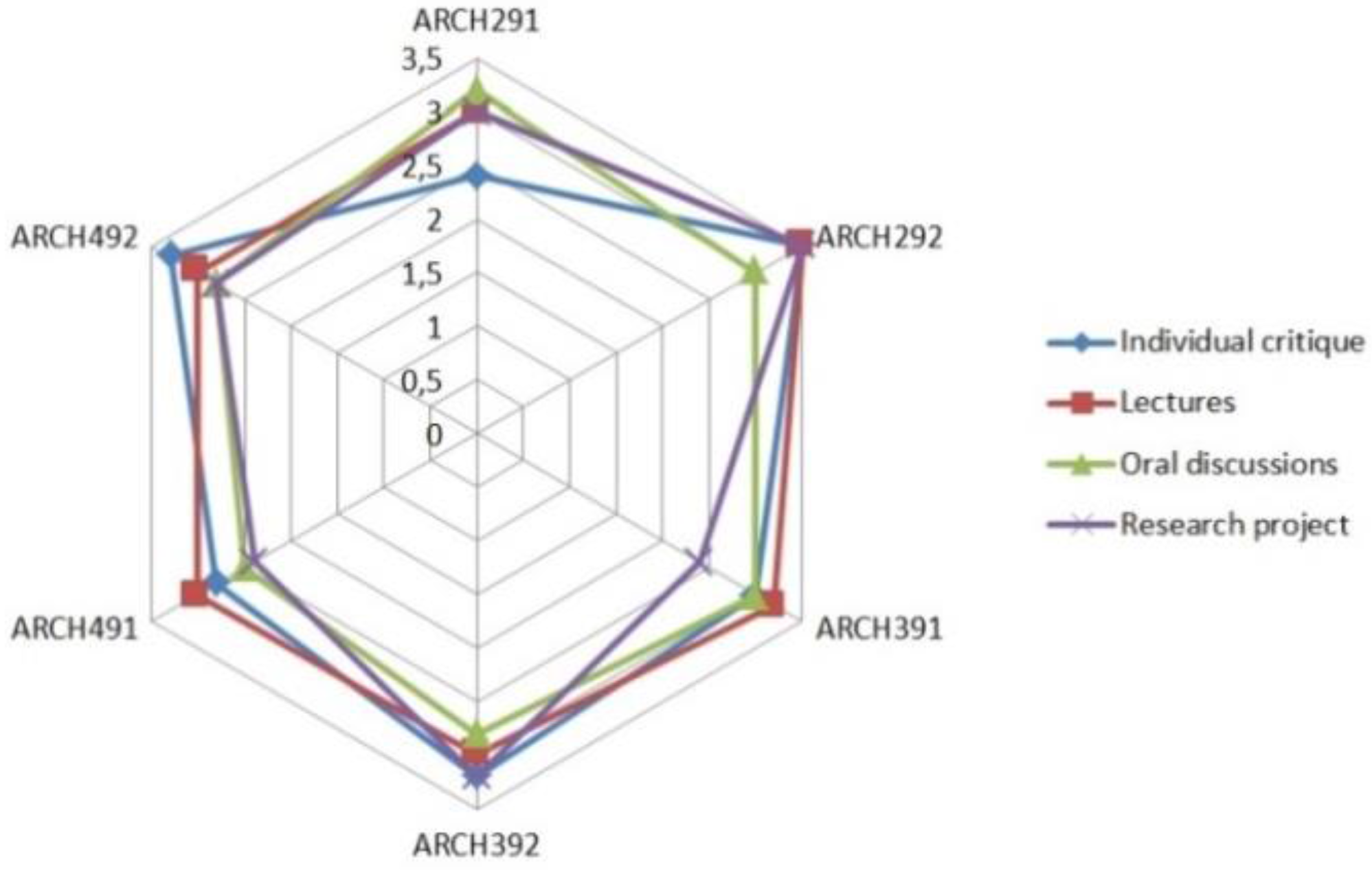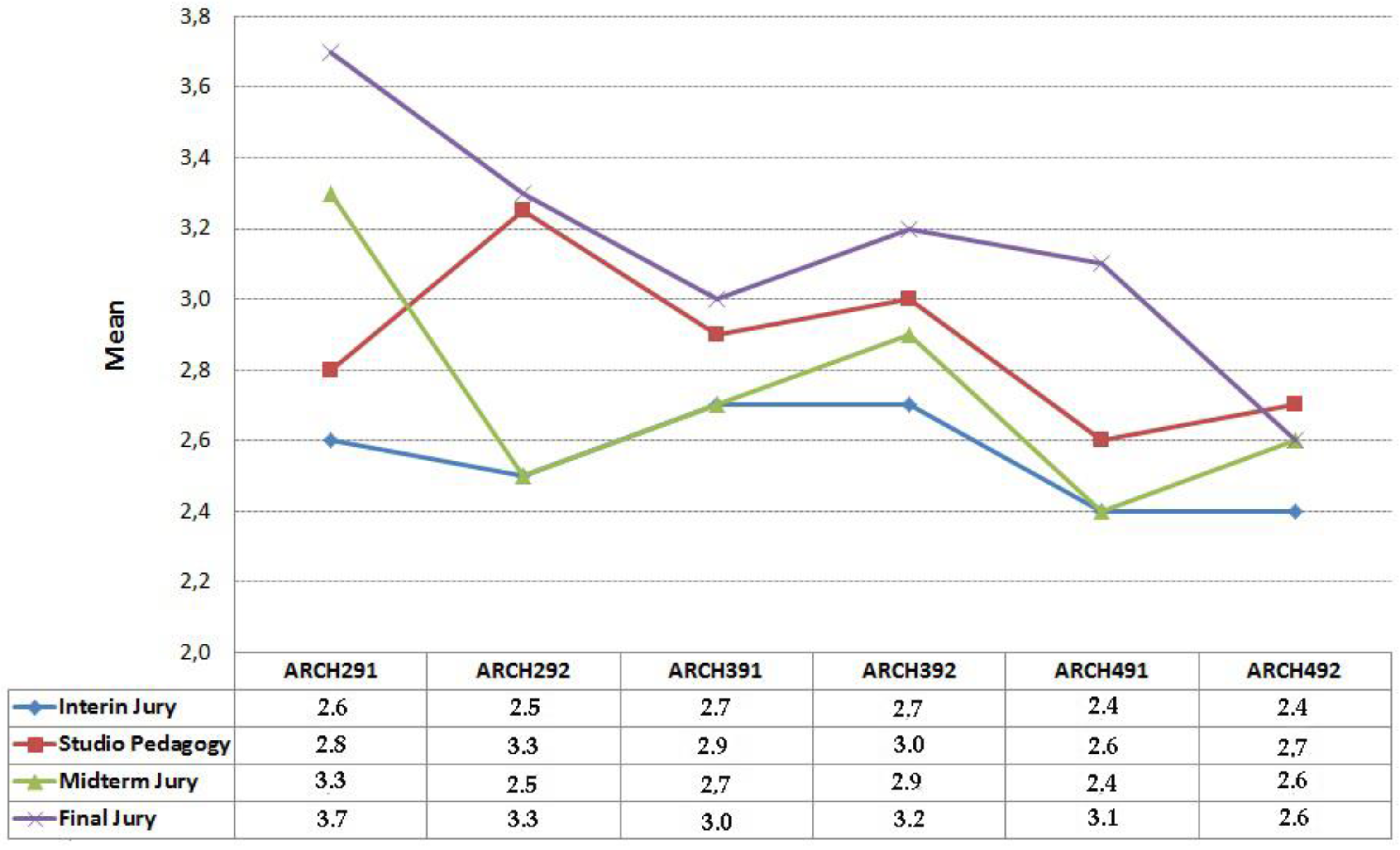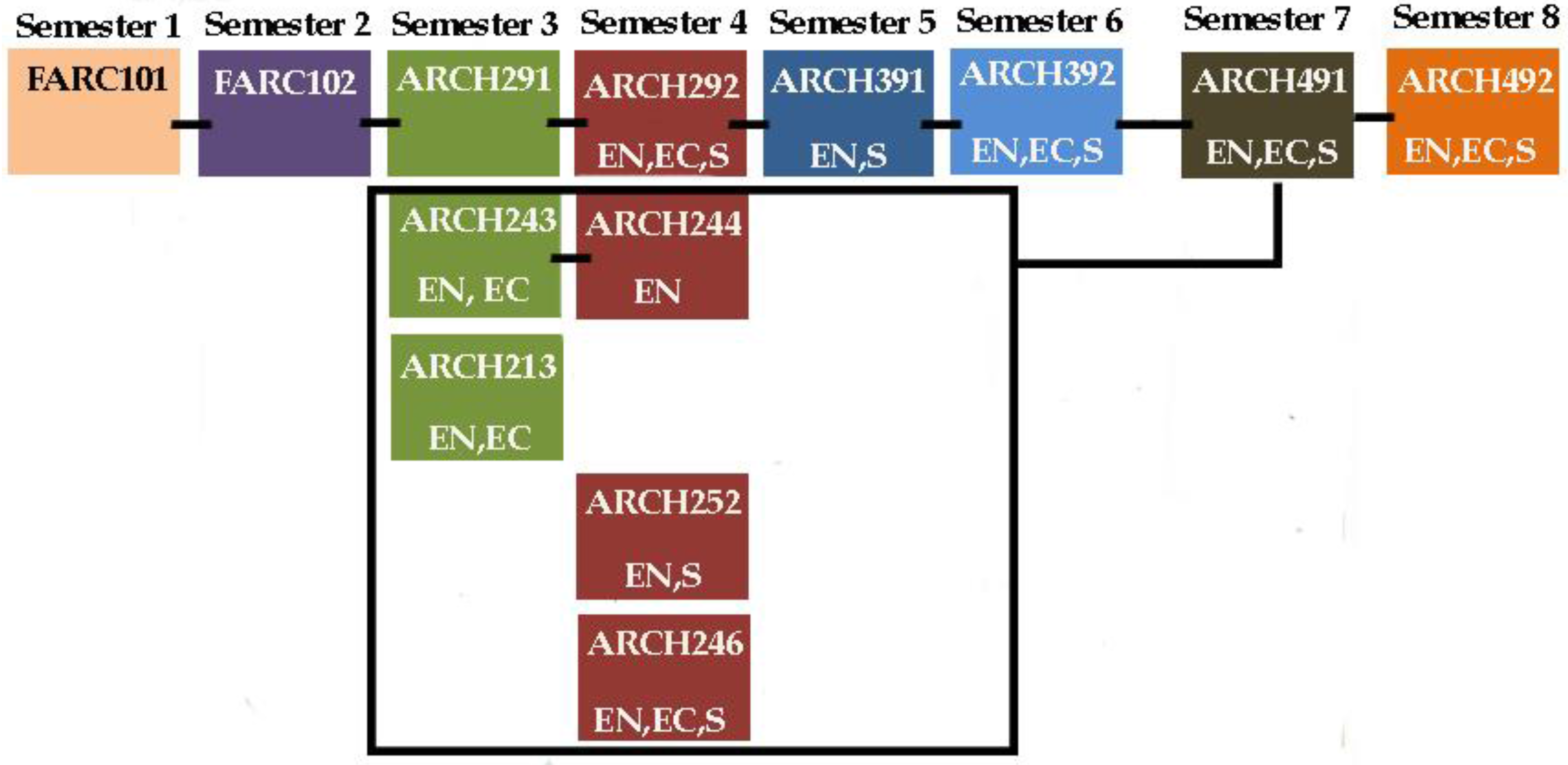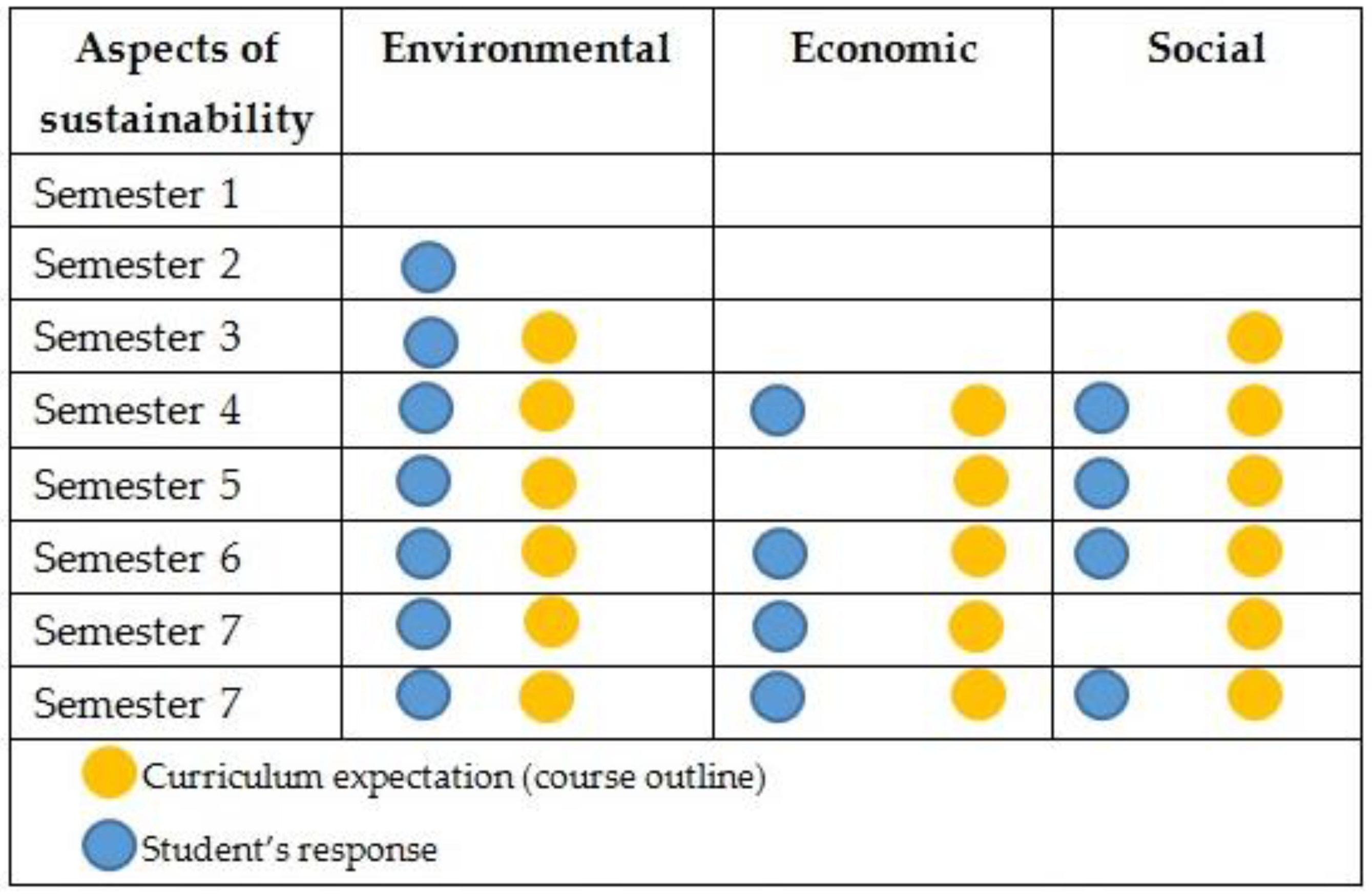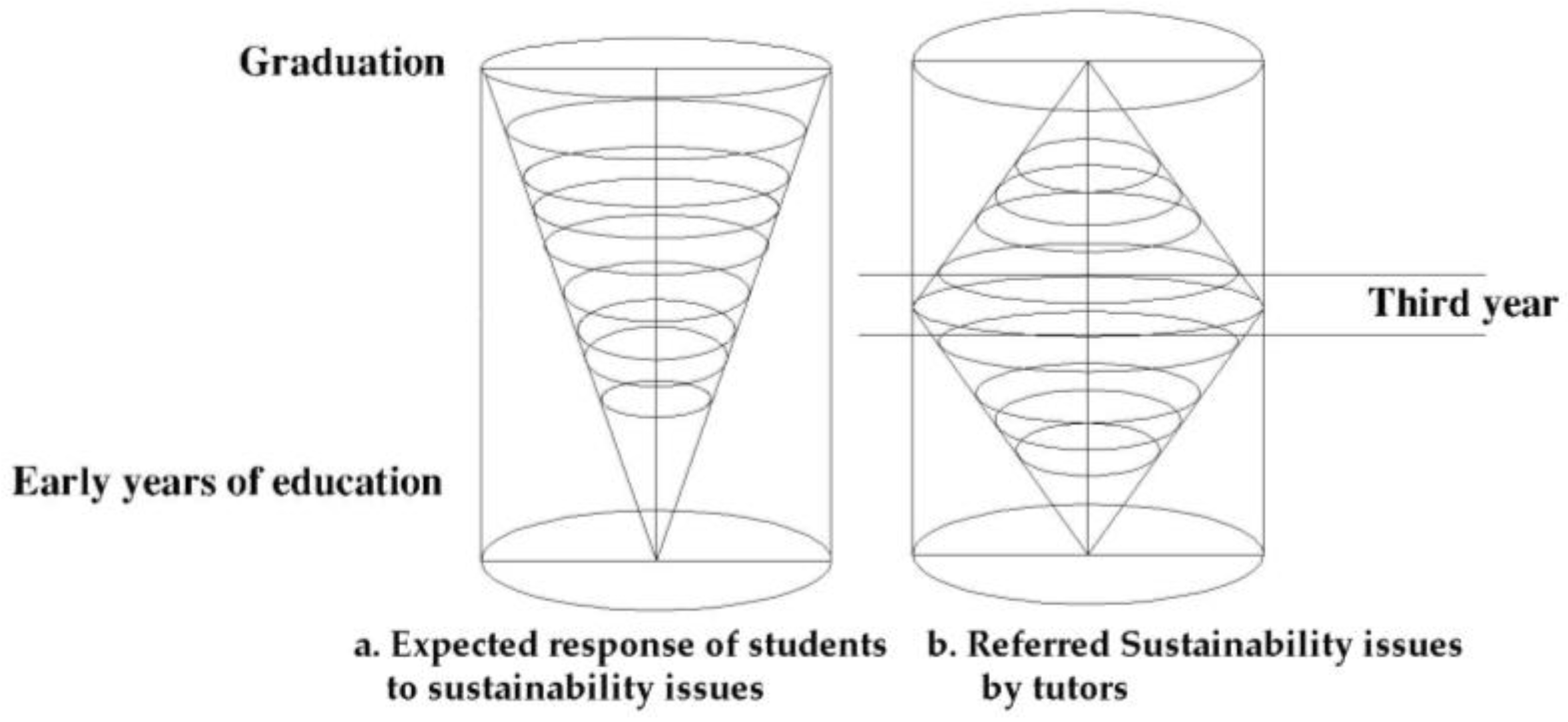1. Introduction
The United Nations Conference on the Human Environment that took place in Stockholm in 1972 introduced sustainability in response to the threat posed to the environment. The concept was further developed in 1992 when it was discussed at the Rio de Janeiro conference. Since then, it has been discussed as part of various priorities in different periods under diverse terminologies and titles [
1]. The term ‘sustainability’ has been broadly used in the field of architecture and urban planning [
2]. Hawkes (1996) [
3] and Hagan (2001) [
4] theorised that a direct relationship between architecture and the environment exists, and the major role played by both factors in providing for basic human needs [
5]. From the 1970s until 2000, the focus of local and international movements changed from environmental design in 1970 to green design in 1980, to ecological design in 1990, and finally to sustainable design in 2000. There are subtle differences between these terminologies. The US Green Building Council [
6] stated that “green design often implies an interest in design that protects people’s health and well-being, while sustainable design also protects the global environment and the world’s ecosystems for future generations”.
Although there are many approaches in defining sustainability, they have common measures. Gibson (2005) [
7] defined sustainability as “a global procedure that attempts to present an enduring future in which environmental, social, and economic features are considered”. Yilmaz (2006) [
8] describes sustainability as a connective method for nature and humanity in the context of time. The current popular concept of sustainability urges society to be flexible enough to avoid destroying the economic, social, and natural systems that support it [
9]. Sustainability in architecture is a subject that does not relate to a specific style of architecture; rather, it is an outcome of activities involved in building and construction that can assist in providing aid to humanity and the environment. Building environment is the main content of human life, and it enables a better quality of life. As a result, sustainability was found to be a goal to achieve by means of different aspects of design [
10].
Some of the fundamental principles of good design are achieved by paying attention to factors such as: local climatic conditions, the position and orientation of building structures, topography, local architectural form, the local environment, applying local construction techniques, using local materials, designing windows, shading devices and louvres, recycling, minimising preservation costs by pre-planning, and flexible design from providing possibilities for altered usage in the future [
11]. Arguably, the aforementioned topics should be considered as subjects for inclusion into the architectural profession as part of its integrated approach. Architectural education has always demonstrated awareness of its influences on cultural constructs [
12,
13,
14]; for example, by reflecting changes in the professional landscape.
Therefore, institutions should adopt sustainability as a priority by motivating students to adopt the essentials of sustainable improvement through using appropriate pedagogical techniques, methods and tools, as well as by ensuring sufficient research [
15]. Education is of paramount importance [
13]; it is the process of facilitating learning and acquisition of knowledge, skills, and academic content, which is taught in a school or in a specific programme. Architects’ ability to create or design sustainable buildings is closely related to them obtaining skills, knowledge, and abilities in this subject during the education process [
16]. The curriculum at the core of architectural education contains plans, objectives, teaching methods, and content that are used to conduct educational activities and attain certain educational aims.
The curriculum relates knowledge from one lesson to the next across a programme of study, and it integrates knowledge across different classes. An integrated curriculum uses both vertical and horizontal articulations. In a vertical articulation, what is learned in one lesson prepares students for the next lesson. It establishes skills and knowledge that are used in further developments across a whole programme of study. In this way, basic skills and knowledge are both developed and reinforced as other elements are introduced into study. This method of teaching is structured and progressive, and it focusses on building advanced levels of knowledge. Horizontal articulation means that what is studied in one particular course in an institution is in line with other, similar classes, both in terms of course content and evaluation [
17]. Creating a single, unified curriculum that avoids clashes between components requires functional interdependence, mutual adaptation, and clarification of interfaces and junctions, which also helps to decrease abortive work. Therefore, curricula need to include a framework to achieve a certain level of educational quality.
Moreover, the whole procedure has to be active rather than passive. This means that the whole education process should provide students with the capability to use their new knowledge in real life [
18]. In this way, students would be encouraged to contend with various ways of looking at problems, to think creatively and become more deeply involved in working on issues that are complicated and multifaceted; this activity can take place in both experiential and classroom settings.
Several important attributes for active education lead to a noticeable changes in student thinking and actions. These attributes include: knowledge, comprehension, application, analysis, synthesis, and evaluation [
19]. Knowledge identifies and refers to a category of situations and behaviours that focus on remembering subjects, thoughts, and events such as recognition and recall. Knowledge can be categorised as a variety of accurate and reasonable information that includes both general and abstract information [
19]. The application of knowledge enables students to think and act individually when it comes to finding suitable topics. Therefore, students do not need to be told what an appropriate topic is, or how it can be used.
The analysis concentrates on separating the constituent factors of a topic, determining its internal organisation and the interactions between its components. Synthesis focuses on incorporating factors to produce a new pattern that illustrates a creative behaviour. Evaluation is not necessarily representative of the final procedure of cognitive behaviour. Sometimes, evaluation is an introduction to the start of the recognition procedure, because it comprises the characteristics of a communication bridge between emotional behaviours and cognitive behaviours [
20].
The three main pillars of sustainability are the environmental, economic, and social aspects. These three pillars need to permeate into the undergraduate curriculum in a homogeneous way that considers the organic relations amongst all of the curriculum components.
Despite the striving of many university leaders, the slow rate of change in universities shows the depth of the challenge [
21].
Attaining sustainable competency in architecture students has been tried trough several influential architecture schools’ endeavors. As an example, a Philadelphia university in the United States (US) implemented a collaborative curriculum into the architecture programme [
22]. Instructors from other disciplines were invited to join at various intervals to provide diverse feedback to architecture students and to draw their attention to universal design principles, energy efficiency, practical issues, and so on.
Ball State University, in Indiana in the US, is another example of a programme that creates situations for several voices in the studio and that also develops interdisciplinary methods between ecologists, sociologists, designers, and so on [
23].
The other exploratory study was done by analyzing the curricula of 20 selected influential schools in 11 countries in Far East Asia [
14]. However, only a limited number of architecture programmes have attempted to find solutions for mutual goals by establishing a situation in the design studio pedagogy and curriculum in a holistic manner [
21].
Accreditations can be an aid to obtain standard quality values and assure the incorporation of sustainability into the curriculum through determined curriculum assessment tools by means of realms and criteria. The most reputable architectural accreditation boards are the NAAB (National Architectural Accreditation Board) and RIBA (Royal Institute of British Architects). They require an architectural programme report based on student performance as one of the main evaluation criteria [
24]. NAAB divides student performance criteria into three realms (A, B, and C) with elaboration on each criterion of different realms. The explained criterion details that need to be addressed and incorporated into the syllabus were used as a tool to indicate the sustainability themes in
Table 1. As
Table 1 indicates in grey colour, students performance criteria elaborates on the theme of sustainability in several places.
It requires knowledge of the principles and concepts of sustainability in creating urban design and architectural projects to be embodied within course contents and objectives, and sustainability must be demonstrated in student studio projects [
24].
As
Table A1 indicates, in RIBA-defined categories, there are 11 main sections in the General Criteria for Parts I and II; these comprise 33 sub-criteria that address aesthetics and technical, structural, and planning considerations, including cost requirements. Sustainability is considered within these sub-criteria in the relationship between people and buildings, as well as with the environment, and the impact of buildings on the environment. The precepts of sustainable design are also mentioned.
Addressing sustainability also involves considering underlying physical problems and technological criteria, which include principles associated with designing optimum audio-visual comfort, thermal comfort, and systems for environmental comfort. These criteria are realised within the relevant precepts of sustainable design, and the ability to integrate these in a design project.
In addition to these factors, the professional criterion in Part III includes an emphasis on environmental sustainability legislation under legal frameworks and process criteria [
25].
The terms knowledge, understanding, ability, and skills are used in the general criteria to indicate the nature of achievement required as the student progresses.
Recently, RIBA has been working intensively with the government to create a new policy regarding sustainability development in architecture [
25].
It is clear that each of the aforementioned boards has, to varying extents, embraced sustainability; however, all of the aspects are considered only broadly, and they are co-equally dispersed.
Findings from the aforementioned studies acknowledge that there is currently no definite path towards a holistic and integrated sustainability knowledge into the curriculum, and there is no agreed approach for delivering the acquisition of this knowledge to students.
While there is a certain amount of will, many universities, schools and programmes cannot determine ways to incorporate a new pedagogical emphasis into traditional settings; consequently, the orientation towards sustainable design is also affected [
21,
23,
25,
26,
27,
28,
29].
Several architecture schools and departments have attempted to discover appropriate ways to improve sustainability integration in architectural education; however, the challenge to change is more intentional than operational, and even then, it is mostly infrequent and uncoordinated [
30,
31].
This paper aims to provide an insight into an operational framework towards the balanced incorporation of sustainability in architectural programmes. The applied analysis provides a possible operational tool to maintain a standard of education with regard to sustainability issues within architectural programmes. The curriculum of architectural programmes is a vital consideration in order to to support architectural education for further professional experiences.
2. Method
In order to assess the level of integration of sustainability programs in an Eastern Mediterranean location, a case study methodology was employed.
Since accreditation is accepted as an assessment tool for achieving a quality review, an aid to obtain standard quality values, and a driving force for further developments and continuous improvement [
32], studying the components of accredited architectural programmes provides a reliable source of evaluation in terms of the level of sustainability incorporation.
The architecture programme at Eastern Mediterranean University in North Cyprus was recently (1 January 2016) awarded substantial equivalence by NAAB, and was found to be a valuable case study. In total, 550 students enrolled in the substantially equivalent degree program. This number includes all of the registered students in the program at the end of the 2013–2014 spring semester.
To comprehend the prevailing situation relating to sustainability incorporation, a multi-layered methodology was deployed. All of the components of the selected case study (an architecture programme at Eastern Mediterranean University) curriculum have been studied in regard to the incorporation of sustainability issues. A required architectural program report (APR) by accreditation boards requires clarification about recent performance relating to student learning, the curricular framework, and student achievements, and is used as a self-study tool for the programme.
All of the details derived from the programme were tabulated and charted, including the used evaluation criteria in jury sessions. The various factors scrutinised included course description, teacher and student opinions about incorporating sustainability within each course, and the prepared architectural programme report (APR) from 2014. Then, the horizontal and vertical articulation and manner of coordination were studied. Finally, the particular features and attributes of the programme were considered, and general recommendations were developed. Below items have been selected as the main components of an applied research methodology.
2.1. Participants
The architecture programme at EMU offers a four-year integrated curriculum. The curriculum allows students to enrol in lectures that are complementary to the general education philosophy of the university. The main focus is that the architectural design studio is augmented by professional theory courses and first-year service courses. The interactive studio, as the proper arena for critical thinking, provides a milieu to address the social, technical, and environmental issues surrounding an architectural project, through recreation of, and discussion about, the spatial dimension of the built environment. Undergraduate courses are categorised as: first-year foundation, design, theoretical (area), area elective and university elective (general education). The programme contains a total of 47 courses (158 credits, including summer practices) and syllabuses. The first semester includes 20 credits, the second to sixth semesters each contain 21 credits, the seventh semester comprises 18 credits, and the eigth semester has 15 credits. The full curriculum is shown in
Table A2. There are 29 professional studies included within 47 courses. When the distribution of the professional studies that begin in the second year is taken into consideration, it can be seen that there are 13 courses available in the second year, 11 in the third year, and four in the fourth year (including the summer practices, which have no credits). According to their area of interest, students must enroll in five professional elective courses offered by the architecture faculty. University elective courses taken in subsequent years give students the opportunity to select courses according to their areas of interest.
The respondents of this study survey were 293 students and instructors in the department of architecture at EMU. All of the participants in this study were volunteers. Student participants included 162 male and 108 females between the ages of 18 and 23. These 270 volunteer students (45 percent of the total student number) were from six design studios in the second, third, and fourth year of their architecture education (referred to as Arch291, Arch292, Arch391, Arch392, Arch491, and Arch492).
To increase the reliability of the results, first-year students were excluded from this part of the survey due to their lack of knowledge and experience in architecture education.
Instructors in the department of architecture who participated in the survey were mainly the coordinators of the design studios and the theoretical courses within the last two years of the research. In total 23 instructors comprising three Prof. Dr, six Assoc. Prof. Dr, and eight Asst. Prof. Dr. and four senior lecturers.
2.2. Material and Measures
Student questionnaires developed by the authors were based on indicators of accreditations and comprised four questions. The first three questions were designed based on a Likert scale from one to five. The questions asked respondents to compare the level of sustainability incorporation in design studios, and in elective and theoretical courses. The aim of questions was to reveal the teaching and learning methods used to transmit sustainability issues, and ultimately to determine how much sustainability was considered by juries as an evaluation criterion while commenting and grading. The final question in the student questionnaire named all 30 “must” courses where they believed sustainability issues were discussed, and ought to mark the aspect(s) covered.
Course descriptions for all of the “must” courses in the programme and the course matrix in APR (prepared for a second visit by NAAB to EMU’s Faculty of Architecture in the 2014–2015 academic year) were reviewed in a comparative study. These results are shown in Table 5, and they were analysed qualitatively.
In the entire architectural education process, each design studio is supposed to deliver special challenges. FARC101 aims to help students learn about formal elements used in design, their characteristics, and the principles that are used in creating design works. Subjects related to human dimension, functional requirements, and form–function relationships are also dealt with.
FARC102 aims to familiarise students with the basic issues of design, and introduce these issues with the help of a small-scaled introductory design project.
ARCH291 expects students to deal with the issues of designing small-scaled complexes, and main include accommodation that serves the human behaviour of a special user group (age, interest, profession, etc.) in a given rural context as the site. ARCH292 aims to develop architectural design skills or students on reasonably complex design in terms of contextual and functional issues in architecture. Accordingly, this course provides an understanding of form, function, and space relations based on projects with fairly complex functions that are in a settled district or neighborhood. The emphasis is on a holistic design approach that is initiated from an architectural scenario and carried through to site, and includes considerations for the environment (design with nature, using topography in design, sun–wind direction, orientation and other climatic factors), special needs in relation to social factors, and appropriate construction techniques, materials, and details.
ARCH 391 aims to develop students’ skills in urban design. Students are expected to design a building complex with functional and spatial sophistication, with particular sensitivity to the existing context, social factors, quality, and hierarchy of open and semi-open spaces, landscaping, urban design issues, and accessibility issues.
ARCH392 aims to provide students with the skills of designing buildings with high complexity in functional structural and constructional terms, while responding to an urban condition with peculiar socio-cultural, economic, and historical parameters.
ARCH491 aims for an emphasis on designing buildings with high complexity in regard to appropriate structural systems, and creating rich architectonic qualities. The course introduces an integrated approach to design. The emphasis is put on the creative design of a building and ensemble that accurately situates the project on the site, while providing a unified form that integrates interior and outdoor space, structure, programme, building construction, and bio-climatic concerns within a viable solution.
ARCH492 is the final project, in which students are expected to work from the macro to the micro scale, and has a special emphasis placed upon individual interest areas. Consideration for the holistic nature of the design product, from the abstract initial form to the final concrete design outcome, is expected to develop throughout the semester. Therefore, progress throughout the design process is important. Professional abilities include architectural research, literature survey and time management skills, and almost full attendance at reviews and discussions. Midterm, pre-final, and final juries are also required.
Curriculum, syllabus, and course descriptions are more content-based, whereas teaching methods, teaching tools, pedagogy, and the evaluation system are part of the process of imparting knowledge. To achieve the aims of each studio and to boost the vertical coordination, different jury members from upper and lower educational levels are invited to the midterms and to the final juries. Therefore, the percentages of internal and external jury members are assigned according to tutor–student relationships within each educational semester. Since midterm and final juries are the main measures in evaluating course outcomes, coherencies amongst process, the final product, and applied criteria in juries needs to be explored. Hence, it was brought to the research as one of the main measures in evaluating the role of sustainability involvement in each studio.
2.3. Procedure
The survey was administered to review and identify the substantive contributions of each course within an assigned semester and within the whole curricula in supporting students’ competencies regarding sustainability issues. Peer review provides a valuable opportunity to scrutinise the complicated matrix of horizontally and vertically related courses from an operational perspective. Therefore, studying course descriptions, teacher and student ideas about courses, and prepared APRs could help uncover the hidden truth in thematic studies.
Four measures, including course outline, student opinion, tutor opinion, and the EMU Architectural Program Report (APR) were set as measuring tools in assessing the sustainability involvement of each course. The questionnaire surveys among students and tutors were synchronised, and the results were checked with the course description and covering realms of APR. It should be noted that the proposal of the research and research method submitted to the relevant committee, and the completed evaluations, were based on the ongoing ethic regulations at the time of study. Participation in this study has been voluntary. The candidates for the research had the right not to participate at all. It was based on the understanding that no identifying information through which the sources of original data can be determined would be made available, and strict controls were maintained to safeguard the confidentiality of the information.
4. Discussion
A programme can never address the magnitude or the complexity of the needs without providing a proper level of articulations amongst courses. Especially in the field of architecture, which is known as a multidisciplinary, multi-skilled, multi-dimensional and multimedia practice. Therefore, the expectation from architectural education should be formulated so that they contextualise theory, design studios, and other components of the curricula in a more integrated framework.
Accordingly, in the analysis of the detailed records of each course, the absence of sustainability issues coverage in any of the studied key determinants (student and tutor perceptions, course description, APR) was considered as exemplary of inconsistency and mismatch.
Courses such as ARCH102 and ARCH 142 are exceptional cases in which the course descriptions and EMU APR did not incorporate sustainability very well. According to the findings in the analysis section, based on tutor and student perceptions, sustainability measures are incorporated according to the priority of the semester. At the very beginning of education, in the early semesters of the curricula, responses to sustainability issues are not part of the main aims and objectives of the expected academic semester.
ARCH291 deals with contextual characteristics of sites without any direct response to the main aspects of the sustainability, which is too complex to consider in the third semester of the curricula. As
Figure 1 indicates, oral discussions, lectures, and research projects are more engaged with the concerns of the sustainability. However, due to vertical coordination before and after semesters, the range of sustainability incorporation in the individual critique is limited by the priority of the semester.
The result indicated in
Table 2 reveal inconsistency and mismatches between the two main actors’ perceptions (students and tutors). Courses that exemplify this inconsistency include ARCH223, ARCH190, ARCH226, and ARCH290. The salient majority of students (255 students out of 270) believed that they did not cover sustainability issues in the named courses, while the tutor(s) acknowledged that at least one sustainability aspect could be incorporated.
According to the system of summer practice (internships) at the school, only ARCH190 is under the supervision of tutors, which includes conducting a site survey and site visit. On the other hand, ARCH290 and ARCH390 are expected to be conducted at construction site and architectural firms or offices.
Juries have been studied as one of the pedagogical tools in design studios; this has been accompanied by direct observations throughout the whole academic year of study. It is revealed that all of the jury members comment upon and follow students’ general and detailed architectural decisions in terms of sustainability at EMU. This tracking by jury members takes place according to students’ expected achievement level, beginning with awareness in the early semesters through to competence level at the point of graduation.
Conversely, it has been revealed that jury members rarely comment on economic sustainability before the last two semesters.
As
Figure 5 indicates, awareness of sustainability issues is first addressed in the second semester of the first year, with further levels of understanding being developed during second-year semesters (the biggest bars show the maximum level of integration). Subsequently, although integrity levels seem to decrease, the application of learned issues will reach a peak, which could be classed as being competent.
In order to explore the operational sustainability incorporation of the curriculum in regard to pedagogical expectations, student perceptions and curriculum references to aspects of sustainability are compared. As
Figure 4 illustrates, in Semesters 4, 6, and 8, the exact expectancy of the curriculum was met, according to student responses. However, still, economic concerns of sustainability were met in Semester 7. Moreover, student responses showed that the environmental aspect of sustainability was met, which is beyond the expectation and aim of the curriculum.
General findings reveal that there is considerable interest about sustainability among students and tutors, and they are highly concerned about sustainability issues. The results shared in the findings section demonstrate these aspects to varying extents, and are in organic relations.
